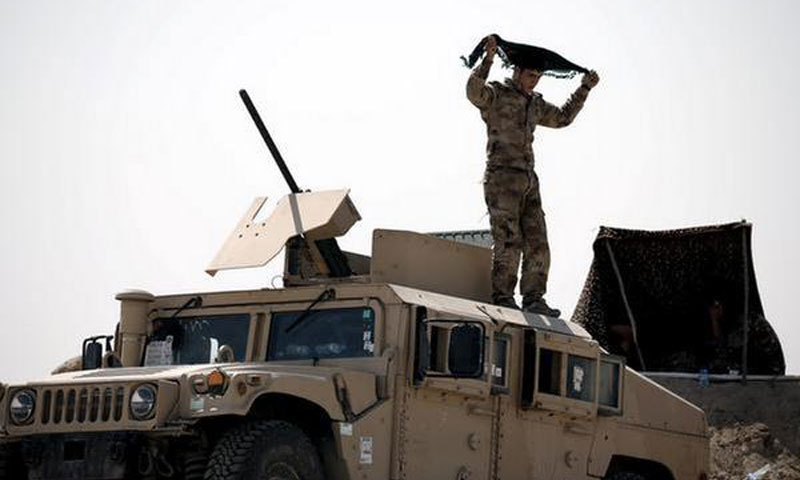The Syrian Democratic Forces dominated the scene in Deir ez-Zor for the past few days, through controlling the largest gas fields in the region after a military conflict with al-Assad’s forces and their supporting militias, which has set the fields as a main target. This was considered as a slap in the face to the Russian ally, away from understandings and planned agreements.
The control of the Conoco and al-Ezba fields, north-east of Deir ez-Zor, came after a two-day siege as part of a military strike launched by SDF to control the rest of the ISIS-controlled territory of Upper Mesopotamia.
Al-Assad loses the race
In a statement issued on Saturday, September 23, SDF said that “the fighters managed at 10 am to liberate al-Ezba and Conoco Petroleum Company, northeast of Deir ez-Zor, after a two-day siege.”
SDF added that “in the meantime, fierce battles continued between the fighters of the Syrian Democratic forces and ISIS mercenaries, during which mercenaries suffered heavy losses, according to preliminary information.”
Al-Assad forces announced, in conjunction with SDF’s siege of the fields, the control the town of Khasham, southeast of the village of Mazloum, the closest point to the “strategic” field of Conoco.
The SDF pointed out that “the fighters of the Deir ez-Zor military council, which belongs to the Syrian Democratic Forces, are making further progress in the countryside of Deir ez-Zor as part of “Al-Jazeera Storm” campaign to liberate the rest of the territory of the Upper Mesopotamia and the eastern bank of the Euphrates River from ISIS mercenaries.”
Tension increased between al-Assad’s forces and SDF against the backdrop of Russian air raids on the SDF sites east of the Euphrates, which were preceded by threats of the Syrian presidential adviser, Bouthaina Shaaban.
Al-Assad’s forces and supporting militias advanced in the western countryside of Deir ez-Zor and were able to lift the siege on their sites in the 137th Brigade and the military airport, to control the entire city.
They launched their military operations again in the south-eastern countryside of al-Raqqa. They managed also to control the entire southern bank of the Euphrates River from al-Tebni northwards to al-Meri’iyaeh in the south, after controlling the strategic area Ma’an.
SDF seek with the support of the International Coalition to dominate the northern part of the city of Deir ez-Zor, under a Russian-American agreement which allows the control of al-Assad forces in the remaining parts of the province, military sources previously told Enab Baladi.
Why are parties competing in Deir Ez-Zor?
According to a 2014 report by the Syrian Network for Human Rights, entitled “The Oil Weapon in Syria,” Deir ez-Zor contains some of the largest oil and gas fields in Syria, the most important of which are al-Omar oilfield in the northeast of the Mayadin city, al-Tanak field in Shu’ytat area in the eastern countryside of the city, in addition to al-Ward field near the village of Dweer in the eastern countryside, Al-Taym field near Mohasan, south of the city, Al-Jafra, 25 km away to east, Conoco Gas Plant, 20 km away east of the city, al-Kharata oil field, 20 km southwest and “T2” pumping station which is located along the Iraqi-Syrian oil pipeline.
In an interview with Enab Baladi, the economic expert Socrates al-Alou attributed the race to control the city to its economic importance, in addition to other reasons. He clarified that “the international competition for the control of the province depends not only on its economic importance, but also on geopolitical reasons related to each party. For Russia and the regime, Deir ez-Zor is an opportunity to expand the land areas of control in a way to strengthen the negotiating position of the regime with the opposition and to impose a Russian solution which consists of al-Assad staying in power in the transitional period, in addition to its economic importance to the regime and its Russian ally that is looking for investment contracts for Syrian oil and gas.”
As for Iran, the city is an alternative route to the US-controlled al-Tanf crossing to achieve its strategic project by connecting Tehran to Beirut through Iraq and Syria.
Whereas, US aims to block the Iranian project in Deir ez-Zor after al-tanf, especially in the area of Abu Kamal.
The city is also a gateway to America in its controlled Syrian areas in the north-east (the Kurdish areas), where several US bases are deployed as part of the US military return strategy to the region after the withdrawal from Iraq.

